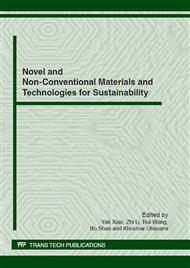p.127
p.135
p.141
p.150
p.158
p.164
p.171
p.179
p.184
Flexural Fatigue Study of Glubam Beams
Abstract:
Three simply supported glue laminated bamboo (glubam), lengthened from bamboo veneer plate with glued and pressed techniques during the process of manufacture, under static experiments compare to three of fatigue experiments to analyze the fatigue damage on the stiffness and strength of bamboo elements followed by modal analysis in method of the integrated modal parameter estimator LMS PloyMax. The main outcomes of the experiments were: (1) fatigue experiment reduced the bearing capacity of glubam beams approximately by 10% due to the weakness of finger-joint and fatigued gluing; (2) when the upper value of cyclic load not surpassed its design value, there were no distinct reduction on the stiffness of specimens comparing to the static group that proved the applicability and validity of the fatigue design value; (3) Excellent flexibility of bamboo contributed to the fine stability of glubam beams in aspect of dynamic response during the fatigue loading. This paper provides an attempting experimental research as the fundamental work and reference for deeper results in the future.
Info:
Periodical:
Pages:
158-163
Citation:
Online since:
June 2012
Authors:
Keywords:
Price:
Сopyright:
© 2012 Trans Tech Publications Ltd. All Rights Reserved
Share:
Citation:


